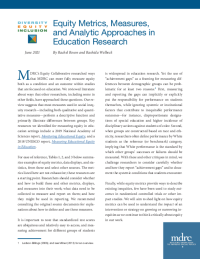Equity Metrics, Measures, and Analytic Approaches in Education Research

 MDRC’s Equity Collaborative researched ways that MDRC can more fully measure equity both as a condition and an outcome within studies that are focused on education. We reviewed literature about ways that other researchers, including some in other fields, have approached these questions. Our review suggests that most measures used in social inequity research—including both qualitative and quantitative measures—perform a descriptive function and primarily illustrate differences between groups. Key resources we identified for measuring equity in education settings include a 2019 National Academy of Sciences report, Monitoring Educational Equity, and a 2018 UNESCO report, Measuring Educational Equity in Education.
MDRC’s Equity Collaborative researched ways that MDRC can more fully measure equity both as a condition and an outcome within studies that are focused on education. We reviewed literature about ways that other researchers, including some in other fields, have approached these questions. Our review suggests that most measures used in social inequity research—including both qualitative and quantitative measures—perform a descriptive function and primarily illustrate differences between groups. Key resources we identified for measuring equity in education settings include a 2019 National Academy of Sciences report, Monitoring Educational Equity, and a 2018 UNESCO report, Measuring Educational Equity in Education.
For ease of reference, Tables 1, 2, and 3 in the full document summarize examples of equity metrics, data displays, and statistics, from these and select other sources. The metrics listed here are not exhaustive; these resources are a starting point. Researchers should consider whether and how to build these and other metrics, displays, and measures into their work; what data need to be collected to measure and report on them; and how they might be used in reporting. We recommend consulting the original source documents for explanations about how to define and use these measures.
It is important to note that standardized test scores are ubiquitous and relatively easy to access, and measuring achievement for different groups of students is widespread in education research. Yet the use of “achievement gaps” as a framing for measuring differences between demographic groups can be problematic for at least two reasons:[1] First, measuring and reporting the gaps can implicitly or explicitly put the responsibility for performance on students themselves, while ignoring systemic or institutional factors that contribute to inequitable performance outcomes—for instance, disproportionate designations of special education and higher incidence of disciplinary actions against students of color. Second, when groups are constructed based on race and ethnicity, researchers often define performance by White students as the reference (or benchmark) category, implying that White performance is the standard by which other groups’ successes or failures should be measured. With these and other critiques in mind, we challenge researchers to consider carefully whether and how they report “achievement gaps” and to document the systemic conditions that students encounter.
Finally, while equity metrics provide ways to describe existing inequities, few have been used to study outcomes in randomized controlled trials or other impact studies. We will aim to shed light on how equity metrics can be used to understand the impact of an intervention or strategy on growing or narrowing inequities as we continue to think critically about equity in our work.
[1] Ladson-Billings (2006); and see Milner (2013) for an overview.






